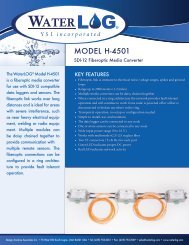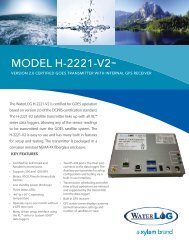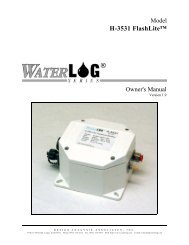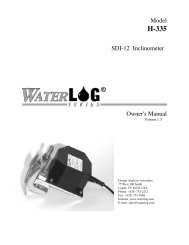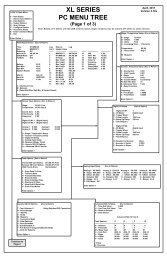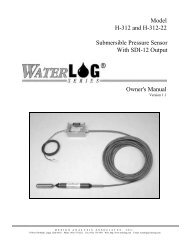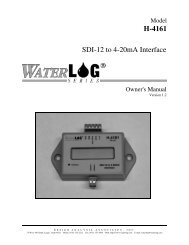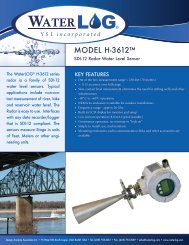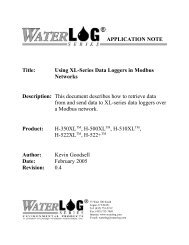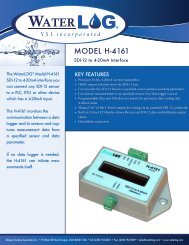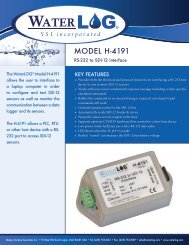RS-232 to SDI-12 Interface Module Model H-4191 ... - WaterLOG
RS-232 to SDI-12 Interface Module Model H-4191 ... - WaterLOG
RS-232 to SDI-12 Interface Module Model H-4191 ... - WaterLOG
- No tags were found...
Create successful ePaper yourself
Turn your PDF publications into a flip-book with our unique Google optimized e-Paper software.
<strong>Model</strong>H-<strong>4191</strong><strong>RS</strong>-<strong>232</strong> <strong>to</strong> <strong>SDI</strong>-<strong>12</strong> <strong>Interface</strong> <strong>Module</strong>Owner's ManualVersion 1.0D E S I G N A N A L Y S I S A S S O C I A T E S , I N C .75 West 100 South, Logan, Utah 84321 Phone: (435) 753-22<strong>12</strong> Fax: (435) 753-7669 Web: http://www.waterlog.com E-mail: waterlog@waterlog.com
Chapter 1Operation1.0 IntroductionThe WATERLOG ® H-<strong>4191</strong> is a <strong>RS</strong>-<strong>232</strong> <strong>to</strong> <strong>SDI</strong>-<strong>12</strong> gateway (interface) module. When connected<strong>to</strong> a personal computer or <strong>RS</strong>-<strong>232</strong> terminal the H-<strong>4191</strong> can be used <strong>to</strong> test and moni<strong>to</strong>r <strong>SDI</strong>-<strong>12</strong>sensors and data recorders. The H-<strong>4191</strong> allows a programable logic controller (PLC), remoteterminal unit (RTU) or other data collection device with a <strong>RS</strong>-<strong>232</strong> interface <strong>to</strong> access <strong>SDI</strong>-<strong>12</strong>sensors. The H-<strong>4191</strong> provides the <strong>RS</strong>-<strong>232</strong> <strong>to</strong> <strong>SDI</strong>-<strong>12</strong> electrical interface, generates the criticalbus timing, parity and command retries needed for the <strong>SDI</strong>-<strong>12</strong> bus pro<strong>to</strong>col..The “<strong>SDI</strong>-<strong>12</strong> Serial-Digital <strong>Interface</strong>” is ideal for data logging applications with the followingrequirements:Battery powered operation with minimal current drainLow system costDigital sensors output data directly in user unitsSensors are interoperable and available from many different manufacturersThe H-<strong>4191</strong> has the following features:Provides both electrical and pro<strong>to</strong>col interface functions between <strong>RS</strong>-<strong>232</strong> & <strong>SDI</strong>-<strong>12</strong>Works with any sensor command/response message including vendor specific extendedcommands.Buffers the command so no special timing is required.Generates proper parity for the <strong>SDI</strong>-<strong>12</strong> bus.Au<strong>to</strong>matically sends <strong>SDI</strong>-<strong>12</strong> retries.Passes the sensor service request <strong>to</strong> the host.Supports optional CTS/RTS hardware flow control for a slow host device.Low power mode facilitates use with a <strong>RS</strong>-<strong>232</strong> data radio.LED shows when the H-<strong>4191</strong> is awake.Built in “sensor” can measure the battery voltage.The H-<strong>4191</strong> is packaged in a rugged plastic enclosure with screw mount ears. Connec<strong>to</strong>rslocated on each end provide easy hookup.H-<strong>4191</strong> Operation 1-1
1.1 ApplicationsFigure 1 shows a moni<strong>to</strong>ring application where a lap<strong>to</strong>p computer is used <strong>to</strong> moni<strong>to</strong>r the <strong>SDI</strong>-<strong>12</strong>communication between a data recorder and two <strong>SDI</strong>-<strong>12</strong> sensors. Figure 2 shows the connectionswhen using the H-<strong>4191</strong> as a gateway between a PLC and two <strong>SDI</strong>-<strong>12</strong> sensors.Figure 4 Moni<strong>to</strong>r a data recorderFigure 3 <strong>Interface</strong> between a PLC andtwo <strong>SDI</strong>-<strong>12</strong> Sensors1.2 OperationThe H-<strong>4191</strong> has a microprocessor with both <strong>RS</strong>-<strong>232</strong> and <strong>SDI</strong>-<strong>12</strong> interface ports. The H-<strong>4191</strong>normally operates as a <strong>SDI</strong>-<strong>12</strong> master device: it issues <strong>SDI</strong>-<strong>12</strong> commands and collects responses.Under certain conditions the H-<strong>4191</strong> can respond <strong>to</strong> host commands itself as a “pseudo” <strong>SDI</strong>-<strong>12</strong>sensor (see Section 1.7).The <strong>RS</strong>-<strong>232</strong> interface port is connected <strong>to</strong> a personal computer or other “host” device. The H-<strong>4191</strong> provides two way communication between the <strong>RS</strong>-<strong>232</strong> host and the <strong>SDI</strong>-<strong>12</strong> bus. Duringnormal operation, the host device sends an address <strong>to</strong>gether with a command <strong>to</strong> a <strong>SDI</strong>-<strong>12</strong> sensor.The sensor then replies with a "response".1-2 Operation H-<strong>4191</strong>
1.2.1 CommandsThe <strong>RS</strong>-<strong>232</strong> host interface is fixed at 9600 baud. The H-<strong>4191</strong> inputs <strong>SDI</strong>-<strong>12</strong> commands (ASCIIcharacters) from the host and places the character string in a buffer. Up <strong>to</strong> 60 characters can bebuffered. The command can be sent at any speed, even hand-typed commands will work. Thebackspace character (08h) is supported and deletes the previous character in the buffer. Note: the<strong>SDI</strong>-<strong>12</strong> pro<strong>to</strong>col requires upper case characters. When the H-<strong>4191</strong> detects the “!” <strong>SDI</strong>-<strong>12</strong>command termina<strong>to</strong>r character the H-<strong>4191</strong> generates a <strong>SDI</strong>-<strong>12</strong> break and transmits the contentsof the buffer <strong>to</strong> the <strong>SDI</strong>-<strong>12</strong> port in a contiguous burst with the proper parity and bus timing. TheH-<strong>4191</strong> also accepts the character (ENTER Key) as a command termina<strong>to</strong>r and substitutesthe character with the required “!” <strong>SDI</strong>-<strong>12</strong> command termina<strong>to</strong>r. This makes the H-<strong>4191</strong>easier <strong>to</strong> use for computer users who more commonly complete a message with the ENTER Key.If you use the ENTER Key <strong>to</strong> terminate the message, do not type the “!” character.The H-<strong>4191</strong> au<strong>to</strong>matically generates <strong>SDI</strong>-<strong>12</strong> compliant parity and timing. After transmitting thecommand, the H-<strong>4191</strong> waits for up <strong>to</strong> 40mS for a sensor response. If the sensor response fails <strong>to</strong>arrive, the H-<strong>4191</strong> performs a retry sequence specified by the <strong>SDI</strong>-<strong>12</strong> pro<strong>to</strong>col. The H-<strong>4191</strong>generates up <strong>to</strong> four breaks with up <strong>to</strong> four retries per break (16 retries <strong>to</strong>tal).1.2.2 Sensor ResponseThe response from a <strong>SDI</strong>-<strong>12</strong> sensor is input by the H-<strong>4191</strong> at <strong>12</strong>00 baud and output <strong>to</strong> the <strong>RS</strong>-<strong>232</strong> port at 9600 baud. Any sensor service requests or other <strong>SDI</strong>-<strong>12</strong> bus traffic are also forwardedfrom the <strong>SDI</strong>-<strong>12</strong> port <strong>to</strong> the <strong>RS</strong>-<strong>232</strong> port. This feature allows the H-<strong>4191</strong> <strong>to</strong> be used <strong>to</strong> passivelymoni<strong>to</strong>r the activity on a <strong>SDI</strong>-<strong>12</strong> bus between a data recorder and its sensors.H-<strong>4191</strong> Operation 1-3
1.3 Making ConnectionsConnect the <strong>RS</strong>-<strong>232</strong> port of the H-<strong>4191</strong> <strong>to</strong> the serial port of your personal computer or other hostdevice with a standard 9-pin <strong>RS</strong>-<strong>232</strong> cable (provided). The H-<strong>4191</strong> has a female connec<strong>to</strong>r and isa DCE (modem) device. The cable has 9-pin <strong>RS</strong>-<strong>232</strong> connec<strong>to</strong>rs which can be plugged directlyin<strong>to</strong> a PC serial port without the use of gender or null-modem adapters. Program your host devicefor 9600 baud, 8-bit, no parity, full-duplex communication The host device must assert eitherCTS or DSR <strong>to</strong> awaken the H-<strong>4191</strong> from it’s low power sleep mode.<strong>RS</strong>-<strong>232</strong> Connec<strong>to</strong>rPin Name Direction Description Function1 nc not used2 TxD Output Transmit Data Transmit data <strong>to</strong> host device3 RxD Input Receive Data Receive data from host device4 DSR Input Data Set Ready Awakens the H-<strong>4191</strong> when asserted.5 GND Ground Ground6 nc not used7 CTS Input Clear To Send Awakens the H-<strong>4191</strong> when asserted.Controls TxD if RTS/CTS flowcontrol is on.8 RTS Output Request To Send Asserted when awake and outputbuffer is not full9 nc not usedThe H-<strong>4191</strong> has a 4-positionterminal strip for makingconnections <strong>to</strong> the <strong>SDI</strong>-<strong>12</strong>bus. The H-<strong>4191</strong> is poweredfrom the +<strong>12</strong>V powerterminal.1-4 Operation H-<strong>4191</strong>
1.4 Testing the <strong>Interface</strong>You can test the H-<strong>4191</strong> with a simple <strong>RS</strong>-<strong>232</strong> terminal or computer using a terminal programsuch as Xtalk or Hyperterminal. The terminal program must assert either the CTS or DSR (orboth) input signals <strong>to</strong> the H-<strong>4191</strong> <strong>to</strong> awaken it from sleep. The red LED on the H-<strong>4191</strong> will beilluminated when it is awake and ready <strong>to</strong> communicate. The interface is a full-duplex connection,depending on the settings of your terminal program you may or may not be able <strong>to</strong> see what youare typing on your screen. If you make a mistake while typing the command, use backspace key <strong>to</strong>delete the previous keystroke. If you make a mistake and are not sure what is in the H-<strong>4191</strong>'sbuffer, press the “!” or ENTER Keys <strong>to</strong> flush the buffer and start over.When the H-<strong>4191</strong> is first powered up it transmits a “H-<strong>4191</strong> Initialized” debugging message <strong>to</strong>the <strong>RS</strong>-<strong>232</strong> port.1.4.1 H-<strong>4191</strong> Initiates the CommandsTry the following commands. The sensor address in these examples is “0" and the sensor is aDesign Analysis H-350 pressure sensor. If your sensor has a different address use the appropriateaddress.1. Check <strong>to</strong> see if you can communicate with the sensor.Issue a “0I!” Identify command.The sensor should respond with: “0<strong>12</strong> DAA H-350001S#000000V10”2. Make a measurement.Issue a “0M!” command.The sensor should respond with: “00153”After 14 seconds the sensor will send a service request: “0Issue a “0D0" command <strong>to</strong> collect the data.The sensor should respond with: “0+4.56+0.0000+0.2”1.4.2 H-<strong>4191</strong> Moni<strong>to</strong>rs the <strong>SDI</strong>-<strong>12</strong> BusThe H-<strong>4191</strong> can be used <strong>to</strong> passively moni<strong>to</strong>r the activity on a <strong>SDI</strong>-<strong>12</strong> bus. You can observe boththe commands from the data recorder and the responses from the sensors. The communicationsbetween a data recorder and a <strong>Model</strong> H-350 pressure sensor would appear as follows:0M!001530D0!0+4.56+0.0000+50.0In this example the data recorder issued a “0M!” command, the sensor responded with“00153 “ (sensor 0, measurement time = 015 sec, 3 parameters will be returned).Next, the data recorder issued a “0D0!” command and the sensor responded with“0+4.56+0.0000+50.0 (sensor 0, stage = 4.56, PSI = 0.0, temperature = 50.0).H-<strong>4191</strong> Operation 1-5
When moni<strong>to</strong>ring traffic between a data recorder and its <strong>SDI</strong>-<strong>12</strong> sensors, the display maysometimes have spurious characters which prefix the command. For example:p0M!00153p0D0!0+4.56+0.0000+50.0The lower case “p” in this example was caused by the break pulse generated by the data recorder.A “break” is a <strong>12</strong>mS or longer pulse on the data line which wakes the sensors from their lowpower sleep mode. The serial asynchronous receiver transmitter (UART) in the H-<strong>4191</strong>misinterprets the break as a random character.1.5 Low Power OperationThe H-<strong>4191</strong> normally reverts <strong>to</strong> a low power or “sleep” mode. If either the DSR or CTS <strong>RS</strong>-<strong>232</strong>inputs are active (asserted) the H-<strong>4191</strong> awakens, powers up its <strong>RS</strong>-<strong>232</strong> transceiver and isavailable for full operation. The red LED on the side of the enclosure is illuminated when the H-<strong>4191</strong> is awake. Most PC terminal programs au<strong>to</strong>matically assert both DSR and CTS by default.When the H-<strong>4191</strong> is connected <strong>to</strong> a PC the H-<strong>4191</strong> will normally awaken and remain awake aslong as it is connected.1.6 Operation with a RadioApplications often arise where a <strong>SDI</strong>-<strong>12</strong> sensor must be physically located hundreds or thousandsof feet from the data logger. Transparent wireless <strong>SDI</strong>-<strong>12</strong> bridges are available for theseapplications. Unfortunately, transparent bridges can miss or drop measurements because ofcorrupted radio packet transmissions. Wireless bridges are problematic because the <strong>SDI</strong>-<strong>12</strong>pro<strong>to</strong>col provides insufficient time <strong>to</strong> make retries or other recovery.When coupled with a data radio, the H-<strong>4191</strong> can be used <strong>to</strong> construct a “non transparent”wireless <strong>SDI</strong>-<strong>12</strong> link. With this architecture the H-<strong>4191</strong> is permanently connected <strong>to</strong> one or moresensors at the remote site. A pair of <strong>RS</strong>-<strong>232</strong> data radios are installed between the data logger andthe remote H-<strong>4191</strong>. The data logger must be setup <strong>to</strong> initiate and collect <strong>SDI</strong>-<strong>12</strong>commands/responses from a <strong>RS</strong>-<strong>232</strong> port instead of its normal <strong>SDI</strong>-<strong>12</strong> port. <strong>SDI</strong>-<strong>12</strong> commandsfrom the data logger are forwarded via the radios <strong>to</strong> the remote H-<strong>4191</strong>. When the remote dataradio receives an inbound data packet, it pulses the CTS input which awakens the H-<strong>4191</strong> inpreparation <strong>to</strong> receive the inbound message. When the H-<strong>4191</strong> detects the “!” character, ittransmits the contents of its buffer <strong>to</strong> the remote <strong>SDI</strong>-<strong>12</strong> bus in a contiguous frame with properparity and bus timing. The H-<strong>4191</strong> waits for and collects any sensor response and forwards it <strong>to</strong>the radio. The sensor response is sent over the radios <strong>to</strong> the data logger. If one or more of theradio transmissions is lost or corrupted, the data logger can retry the entire sequence as needed.The H-<strong>4191</strong> has an internal inactivity timer which keeps the module awake <strong>to</strong> process the servicerequest and receive subsequent radio packets. If both the <strong>RS</strong>-<strong>232</strong> and <strong>SDI</strong>-<strong>12</strong> ports becomeinactive (and both CTS and RTS are not asserted) for longer than 10-seconds, the timer expiresand the H-<strong>4191</strong> enters its low power sleep mode. The H-<strong>4191</strong> examines the“aTTTN” sensor response initiated by an “aM!” measure command and initializes asecond “keep-awake” timer <strong>to</strong> TTT + 3-seconds. This ensures the H-<strong>4191</strong> will remain awake <strong>to</strong>1-6 Operation H-<strong>4191</strong>
process the service request. When the service request actually arrives, the keep-awake timer iszeroed. While the keep-awake timer is running the H-<strong>4191</strong> sends a null (00h) <strong>to</strong> the radioonce/second <strong>to</strong> keep the radio link awake while waiting for the service request.The radios used in this architecture are normally programmed for “sleep & sniff” low poweroperation. When properly configured, the data logger, radios and H-<strong>4191</strong> module can provide alow-power wireless <strong>SDI</strong>-<strong>12</strong> bridge capable of performing retries.1.7 Sensor “Z”When implementing a wireless <strong>SDI</strong>-<strong>12</strong> bridge as described in the previous section it is useful forthe data logger <strong>to</strong> be capable of moni<strong>to</strong>ring the battery voltage in the remote station. In addition<strong>to</strong> functioning as a <strong>RS</strong>-<strong>232</strong> <strong>to</strong> <strong>SDI</strong>-<strong>12</strong> gateway, the H-<strong>4191</strong> has a built-in “sensor” which responds<strong>to</strong> <strong>SDI</strong>-<strong>12</strong> address “Z”. The “Z” sensor can measure the H-<strong>4191</strong>'s +<strong>12</strong>V input voltage, is used <strong>to</strong>facilitate turning flow control On or Off and is useful for testing and maintenance. The “Z” sensorresponds <strong>to</strong> all <strong>SDI</strong>-<strong>12</strong> compliant commands, however, it is only accessible via the <strong>RS</strong>-<strong>232</strong> port.The built-in sensor will not respond <strong>to</strong> a data logger connected <strong>to</strong> the <strong>SDI</strong>-<strong>12</strong> port. The sensoraddress can be changed from “Z” <strong>to</strong> another value if needed with the extendedChange_Address_Command. See Section-2 for further details.1.8 <strong>RS</strong>-<strong>232</strong> Hardware Flow ControlThe <strong>RS</strong>-<strong>232</strong> port of the H-<strong>4191</strong> supports optional RTS/CTS hardware flow control for slowPLC’s or RTU’s which cannot input or receive the entire <strong>SDI</strong>–<strong>12</strong> response message. The H-<strong>4191</strong>moni<strong>to</strong>rs its CTS input and transmits <strong>RS</strong>-<strong>232</strong> characters only if CTS is asserted. The H-<strong>4191</strong> canbuffer up <strong>to</strong> 60 <strong>SDI</strong>-<strong>12</strong> response characters, any additional input characters will be lost.While the H-<strong>4191</strong> is busy sending a <strong>SDI</strong>-<strong>12</strong> command or doing retries, it can buffer up <strong>to</strong> 32command characters from the <strong>RS</strong>-<strong>232</strong> port. The H-<strong>4191</strong> de-asserts the RTS output when morethan 28 characters are queued in its host input buffer.The H-<strong>4191</strong> comes from the fac<strong>to</strong>ry with the RTS/CTS hardware flow control set <strong>to</strong> Off. Anextended <strong>SDI</strong>-<strong>12</strong> command allows the hardware flow control feature <strong>to</strong> be turned On or Off.The On/Off setting is s<strong>to</strong>red in EEPROM internal <strong>to</strong> the H-<strong>4191</strong> and remains in effect even if thepower is lost. See Chapter 2 for details.H-<strong>4191</strong> Operation 1-7
1-8 Operation H-<strong>4191</strong>
Chapter 2<strong>SDI</strong>-<strong>12</strong> Command and Response Pro<strong>to</strong>col2.0 <strong>SDI</strong>-<strong>12</strong> Command and Response Pro<strong>to</strong>colThis is a brief description of the Serial Digital <strong>Interface</strong> (<strong>SDI</strong>-<strong>12</strong>) Command and ResponsePro<strong>to</strong>col used by the WATERLOG ® Series <strong>Model</strong> H-<strong>4191</strong> sensor. Included is a description of thecommands and data format supported by the H-<strong>4191</strong>.Refer <strong>to</strong> the document "A SERIAL DIGITAL INTERFACE STANDARD FOR HYDROLOGICAND ENVIRONMENTAL SENSO<strong>RS</strong>.” Version 1.2 April <strong>12</strong>, 1996 Coordinated by the <strong>SDI</strong>-<strong>12</strong>Support Group, 135 East Center, Logan, Utah.During normal communication, the data recorder sends an address <strong>to</strong>gether with a command <strong>to</strong>the H-<strong>4191</strong> <strong>SDI</strong>-<strong>12</strong> sensor. The H-<strong>4191</strong> then replies with a "response." In the followingdescriptions, <strong>SDI</strong>-<strong>12</strong> commands and responses are enclosed in quotes. The <strong>SDI</strong>-<strong>12</strong> address andthe command/response termina<strong>to</strong>rs are defined as follows:"a"Is the sensor address. The following ASCII Characters are valid addresses:"0-9", "A-Z", "a-z", "*", "?". Sensors will be initially programmed at thefac<strong>to</strong>ry with the address of "0" for use in single sensor systems. Addresses"1 <strong>to</strong> 9" and "A <strong>to</strong> Z" or "a <strong>to</strong> z" can be used for additional sensorsconnected <strong>to</strong> the same <strong>SDI</strong>-<strong>12</strong> bus. Address "*" and "?" are "wild card"addresses which select any sensor, regardless of its actual address."!" Is the last character of a command block.Notes:"" Are carriage return (0D) hex and line feed (0A) hex characters. They arethe last two characters of a response block.• All commands/responses are upper-case printable ASCII characters.• Commands must be terminated with a "!" character.• Responses are terminated with characters.• The command string must be transmitted in a contiguous block with no gaps of morethan 1.66 milliseconds between characters.H-<strong>4191</strong> <strong>SDI</strong>-<strong>12</strong> Command and Response Pro<strong>to</strong>col 2-1
2.1 Measure CommandThe Measure Command causes a measurement sequence <strong>to</strong> be performed. Data values generatedin response <strong>to</strong> this command are s<strong>to</strong>red in the sensor's buffer for subsequent collection using "D"commands. The data will be retained in the sensor until another "M", " C", or "V" command isexecuted.Command Response Description"aM!" "atttn" Initiate measurementWhere:a is the sensor address ("0-9", "A-Z", "a-z", "*", "?").Mtttnis an upper-case ASCII characteris a three digit integer (000-999) specifying the maximum time, in seconds, thesensor will take <strong>to</strong> complete the command and have measurement data available inits buffer.is a single digit integer (0-9) specifying the number of values that will beplaced in the data buffer. If "n" is zero (0), no data will be available usingsubsequent "D" commands.Upon completion of the measurement, a service request "a" is sent <strong>to</strong> the data recorderindicating the sensor data is ready. The data recorder may wake the sensor with a break andcollect the data any time after the service request is received or the specified processing time haselapsed.Example of a H-<strong>4191</strong> "aM!" command:Command Response Time Values Description"ZM!" "Z0021" 2 sec 1 Make measurementSubsequent Command Response"ZD0" Z+AA.AAWhere:AA.AA = Battery Voltage (@ <strong>SDI</strong>-<strong>12</strong> +<strong>12</strong>V power pin)2-2 <strong>SDI</strong>-<strong>12</strong> Command and Response Pro<strong>to</strong>col H-<strong>4191</strong>
2.2 Concurrent Measurement CommandThis is a new command for the Version 1.2 <strong>SDI</strong>-<strong>12</strong> Specification. A concurrent measurement isone which occurs while other <strong>SDI</strong>-<strong>12</strong> sensors on the bus are also taking measurements. Thiscommand is similar <strong>to</strong> the “aM!” command, however, the nn field has an extra digit and the sensordoes not issue a service request when it has completed the measurement. Communicating withother sensors will NOT abort a concurrent measurement. Data values generated in response <strong>to</strong>this command are s<strong>to</strong>red in the sensor's buffer for subsequent collection using "D" commands.The data will be retained in the sensor until another "M", "C", or "V" command is executed.Command Response Description"aC!" "atttnn" Initiate measurementWhere:a is the sensor address ("0-9", "A-Z", "a-z", "*", "?").C is an upper-case ASCII characterttt is a three digit integer (000-999) specifying the maximum time, in seconds, thesensor will take <strong>to</strong> complete the command and have measurement data available inits buffer.nn is a two digit integer (00-99) specifying the number of values that will beplaced in the data buffer. If "n" is zero (0), no data will be available usingsubsequent "D" commands.The data recorder may wake the sensor with a break and collect the data anytime after thespecified processing time has elapsed.H-<strong>4191</strong> <strong>SDI</strong>-<strong>12</strong> Command and Response Pro<strong>to</strong>col 2-3
2.3 Send Data CommandThe Send Data command returns sensor data generated as the result of previous "aM!", "aC!", or"aV!" commands. Values returned will be sent in 33 characters or less. The sensor's data bufferwill not be altered by this command.Command"aD0!" through "aD9!"Response"apd.d ... pd.d"Where:a is the sensor address ("0-9", "A-Z", "a-z", "*", "?").D0..D9are upper-case ASCII characters.p Is a polarity sign (+ or -)d.drepresents numeric digits before and/or after the decimal. A decimal maybe used in any position in the value after the polarity sign. If a decimal isnot used, it will be assumed <strong>to</strong> be after the last digit.For example: +3.29 +23.5 -25.45 +300If one or more values were specified and a "aD0!" returns no data ( only), it meansthat the measurement was aborted and a new "M" command must be sent.Example of a H-<strong>4191</strong> "aD0!" command:Previous Command Response"ZM!" "Z0021"Subsequent CommandResponse"ZD0" Z+AA.AAWhere:AA.AA = Battery Voltage2-4 <strong>SDI</strong>-<strong>12</strong> Command and Response Pro<strong>to</strong>col H-<strong>4191</strong>
2.4 Continuous MeasurementsThis is a new command for the Version 1.2 <strong>SDI</strong>-<strong>12</strong> Specification. Sensors that are able <strong>to</strong>continuously moni<strong>to</strong>r the phenomena <strong>to</strong> be measured, such as a cable position, do not require astart measurement command. They can be read directly with the R commands (R0!...R9!). The Rcommands work exactly like the D (D0!...D9!) commands. The only difference is that the Rcommands do not need <strong>to</strong> be preceded with an M command.The H-<strong>4191</strong> does not support the aR0! continuous measurement commands because themeasurement and math operations require several seconds <strong>to</strong> complete..2.5 Send Acknowledge CommandThe Send Acknowledge Command returns a simple status response which includes the address ofthe sensor. Any measurement data in the sensor's buffer is not disturbed.Command"a!"Response"a"Where: a Is the sensor address ("0-9", "A-Z", "a-z", "*", "?").H-<strong>4191</strong> <strong>SDI</strong>-<strong>12</strong> Command and Response Pro<strong>to</strong>col 2-5
2.6 Initiate Verify CommandThe Verify Command causes a verify sequence <strong>to</strong> be performed. The result of this command issimilar <strong>to</strong> the "aM!" command except that the values generated are fixed test data and the resultsof diagnostic checksum tests. The data generated in response <strong>to</strong> this command is placed in thesensor's buffer for subsequent collection using "D" commands. The data will be retained in thesensor until another "M", "C", or "V" command is executed.Command Response Description"aV!" "atttn" Initiate verify sequenceWhere:a is the sensor address ("0-9", "A-Z", "a-z", "*", "?").Vtttnis an upper-case ASCII character.is a three digit integer (000-999) specifying the maximum time, in seconds, thesensor will take <strong>to</strong> complete the command and have data available in its buffer.is a single digit integer (0-9) specifying the number of values that will beplaced in the data buffer. If "n" is zero (0), no data will be available usingsubsequent "D" commandsExample of a "aV!" command:Command Response Time Values Description"ZV!" "a0013" 1 sec 3 Return fixed data and diagnostic datafor testing purposes.Subsequent Command"ZD0"ResponseZ+<strong>12</strong>3.456+78.9+yKey Description Units+<strong>12</strong>3.456 Fixed test data+78.9 Fixed test datay ROM checksum test 0 = Failed, 1 = Passed2-6 <strong>SDI</strong>-<strong>12</strong> Command and Response Pro<strong>to</strong>col H-<strong>4191</strong>
2.7 Send Identification CommandThe Send Identification Command responds with sensor vendor, model, and version data. Anymeasurement data in the sensor's buffer is not disturbed.Command"aI!"Response"allccccccccmmmmmmvvvxx...xx"Where:a is the sensor address ("0-9", "A-Z", "a-z", "*", "?").Illccccccccmmmmmmvvvxx...xxis an upper-case ASCII character.is the <strong>SDI</strong>-<strong>12</strong> version compatibility level, e.g. version 1.2 is represented as"<strong>12</strong>".is an 8 character vendor identification <strong>to</strong> be specified by the vendor andusually in the form of a company name or its abbreviation.is a 6 character field specifying the sensor model number.is a 3 character field specifying the sensor version number.is an optional field of up <strong>to</strong> a maximum of 13 characters <strong>to</strong> be used for serialnumber or other specific sensor information not relevant <strong>to</strong> operation of thedata recorder.Example of a "aI!" command:"a<strong>12</strong> DAA H-<strong>4191</strong>vvvS#nnnnnnVkkk"H-<strong>4191</strong> implementation of the optional 13 character field:S#nnnnnnVkkk (<strong>12</strong> bytes <strong>to</strong>tal)Where:"nnnnnn""kkk"is a six character sensor serial numberis a three digit sensor firmware revision levelH-<strong>4191</strong> <strong>SDI</strong>-<strong>12</strong> Command and Response Pro<strong>to</strong>col 2-7
2.8 Change Sensor Address CommandThe Change Sensor Address Command allows the sensor address <strong>to</strong> be changed. The address iss<strong>to</strong>red in non-volatile EEPROM within the sensor. The H-<strong>4191</strong> will not respond if the commandwas invalid, the address was out of range, or the EEPROM programming operation failed.Command Response Description"aAn!" "n" Change sensor addressWhere:aAnis the current (old) sensor address ("0-9", "A-Z", "a-z", "*", "?"). AnASCII "*" may be used as a "wild card" address if the current address isunknown and only one sensor is connected <strong>to</strong> the bus.is an upper-case ASCII character.is the new sensor address <strong>to</strong> be programmed ("0-9", "A-Z").NOTE: To verify the new address use the "Identify Command."Example of a "Change Sensor Address" command:Command Response Description"ZA9!" "9" Change sensor address <strong>to</strong> "9"2-8 <strong>SDI</strong>-<strong>12</strong> Command and Response Pro<strong>to</strong>col H-<strong>4191</strong>
2.9 Extended Read Flow_Mode and Write Flow_ModeThe <strong>RS</strong>-<strong>232</strong> port of the H-<strong>4191</strong> supports optional RTS/CTS hardware flow control for slow hostdevices which cannot input or receive the entire <strong>SDI</strong>-<strong>12</strong> response message. The H-419 moni<strong>to</strong>rsit’s CTS input signal and transmits <strong>RS</strong>-<strong>232</strong> characters only if CTS is asserted.The H-<strong>4191</strong> comes from the fac<strong>to</strong>ry with the RTS/CTS hardware flow control set <strong>to</strong> OFF. Thesetwo commands allow the hardware flow control feature <strong>to</strong> be checked or turned ON or OFF. TheOn/Off setting is s<strong>to</strong>red in EEPROM internal <strong>to</strong> the H-<strong>4191</strong> and remains in effect even if thepower is lost.Once a new Flow_Mode value is written, a copy is sent <strong>to</strong> the sensor data buffer for verification.This data can be viewed by using a subsequent "D" command. To read or verify the value anyother time, use the "XRFM" command.Command Response Description"aXRFM!" “a0011" Read Flow_Mode"aXWFMn!" “a0011" Write Flow_ModeWhere: a is the sensor address ("0-9", "A-Z", "a-z", "*", "?").XRFM are upper case characters.XWFM are upper case characters.n0 = flow control OFF, 1 = flow control ONThis command takes 001 seconds <strong>to</strong> complete and places 1 value in the data buffer. Use the“aD0" command <strong>to</strong> collect and view the current value.Example of a H-<strong>4191</strong> Extended "Read Flow_Control_Mode" command:Command Response Time Values Description"ZXRFM!" "Z0011" 1 sec 1 Read Flow_ModeCommand Response Description"ZD0!" "Z+0" Flow Mode = OFFExample of a H-<strong>4191</strong> Extended "Write Flow_Control_Mode" command:Command Response Time Values Description"ZXWFM1!" "Z0011" 1 sec 1 Write Flow_ModeCommand Response Description"ZD0!" "Z+1" Flow Mode = ONH-<strong>4191</strong> <strong>SDI</strong>-<strong>12</strong> Command and Response Pro<strong>to</strong>col 2-9
2-10 <strong>SDI</strong>-<strong>12</strong> Command and Response Pro<strong>to</strong>col H-<strong>4191</strong>
Appendix ASpecifications<strong>RS</strong>-<strong>232</strong> PortType:Asynchronous, 9600 baud, 8-bit, noparity (fixed)Flow Control: RTS/CTS (optional)Command Buffer: 60 characters<strong>SDI</strong>-<strong>12</strong> PortBaud Rate: <strong>12</strong>00Pro<strong>to</strong>col: <strong>SDI</strong>-<strong>12</strong>, 7-bit even parity, 1 s<strong>to</strong>p bitOutput Voltage Levels:Minimum high level: 3.5 voltsMaximum low level: 0.8 voltsWarrantyThe WATERLOG ® H-<strong>4191</strong> is warranted against defects inmaterials and workmanship for one year from date of shipment.NotesSpecifications subject <strong>to</strong> change without prior notice due <strong>to</strong>ongoing commitment <strong>to</strong> product testing and improvement.Internal Voltage Moni<strong>to</strong>r (Address “Z”)Range: 6-18VResolution: 8-bit (.08V)Accuracy: ±1%Power RequirementsVoltage Input:Supply Current:Sleep ModeActiveSurge Protection:EnvironmentalOperating Temperature:S<strong>to</strong>rage Temperature:9 <strong>to</strong> 16.0 Volts DC100A typ20mA typBuilt in, 1.5 KVA-40° C <strong>to</strong> +50° C-50° C <strong>to</strong> +70° CMechanicalMaterial:SizeConnec<strong>to</strong>rs:<strong>RS</strong>-<strong>232</strong>:<strong>SDI</strong>-<strong>12</strong>ABS plastic3.75" Long x 2.65" Wide x 1.25" Deep9-Pin, female, D-sub, DCE connections4-position terminal strip, pluggable,Phoenix CombiconH-<strong>4191</strong> Specifications A-1




